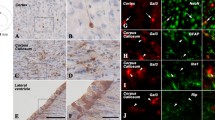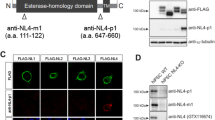Abstract
TFF3 is a member of the trefoil factor family (TFF) predominantly secreted by mucous epithelia. Minute amounts are also expressed in the immune system and the brain. In the latter, particularly the hypothalamo-pituitary axis has been investigated in detail in the past. Functionally, cerebral TFF3 has been reported to be involved in several processes such as fear, depression, learning and object recognition, and opiate addiction. Furthermore, TFF3 has been linked with neurodegenerative and neuropsychiatric disorders (e.g., Alzheimer’s disease, schizophrenia, and alcoholism). Here, using immunohistochemistry, a systematic survey of the TFF3 localization in the adult human brain is presented focusing on extrahypothalamic brain areas. In addition, the distribution of TFF3 in the developing human brain is described. Taken together, neurons were identified as the predominant cell type to express TFF3, but to different extent; TFF3 was particularly enriched in various midbrain and brain stem nuclei. Besides, TFF3 immunostaining staining was observed in oligodendroglia and the choroid plexus epithelium. The wide cerebral distribution should help to explain its multiple effects in the CNS.




Similar content being viewed by others
References
Albert TK, Laubinger W, Müller S, Hanisch FG, Kalinski T, Meyer F, Hoffmann W (2010) Human intestinal TFF3 forms disulfide-linked heteromers with the mucus-associated FCGBP protein and is released by hydrogen sulfide. J Proteome Res 9:3108–3117
Bernstein HG, Schön E, Ansorge S, Röse I, Dorn A (1987) Immunolocalization of dipeptidyl aminopeptidase (DAP IV) in the developing human brain. Int J Dev Neurosci 5:237–242
Bernstein HG, Baumann B, Danos P, Diekmann S, Bogerts B, Gundelfinger ED, Braunewell KH (1999) Regional and cellular distribution of neural visinin-like protein immunoreactivities (VILIP-1 and VILIP-3) in human brain. J Neurocytol 28:655–662
Cadet JL, Jayanthi S, McCoy MT, Beauvais G, Cai NS (2010) Dopamine D1 receptors, regulation of gene expression in the brain, and neurodegeneration. CNS Neurol Disord Drug Targ 9:526–528
Chissoe St, Ehm MG, Jean P St (2008) Genes associated with schizophrenia, US Patent Application Publication US 2008/0176239 A1, pp 1–49
Cui D, Dougherty KJ, Machacek DW, Sawchuk M, Hochman S, Baro DJ (2006) Divergence between motoneurons: gene expression profiling provides a molecular characterization of functionally discrete somatic and autonomic motoneurons. Physiol Genomics 24:276–289
Derbyshire A, Ludwig M (2004) TFF3 induced Fos protein expression in the magnocellular oxytocin neurons of the hypothalamus. Peptides 25:833–838
Fu T, Stellmacher A, Znalesniak EB, Dieterich DC, Kalbacher H, Hoffmann W (2014) Tff3 is expressed in neurons and microglial cells. Cell Physiol Biochem 34:1912–1919
Gardiner EJ, Cairns MJ, Liu B, Beveridge NJ, Carr V, Kelly B, Scott RJ, Tooney PA (2013) Gene expression analysis reveals schizophrenia-associated dysregulation of immune pathways in peripheral blood mononuclear cells. J Psychiatr Res 47:425–437
Griepentrog T, Bauer M, Hornstein C, Sauer H, Jirikowski GF (1999) Tanycytes in the human median eminence contain intestinal trefoil factor (hITF). Eur J Anat 3:111–114
Griepentrog T, Bauer M, Hornstein C, Sauer H, Jirikowski GF (2000) Coexistence of intestinal trefoil factor (hITF) and oxytocin in magnocellular neurons in the human hypothalamus. Horm Metab Res 32:121–124
Hashimoto JG, Forquer MR, Tanchuck MA, Finn DA, Wiren KM (2011) Importance of genetic background for risk of relapse shown in altered prefrontal cortex gene expression during abstinence following chronic alcohol intoxication. Neuroscience 173:57–75
Hauser F, Poulsom R, Chinery R, Rogers LA, Hanby AW, Wright NA, Hoffmann W (1993) hP1.B, a human P-domain peptide homologous with rat intestinal trefoil factor, is expressed also in the ulcer-associated cell lineage and the uterus. Proc Natl Acad Sci USA 90:6961–6965
Hinz M, Schwegler H, Chwieralski CE, Laube G, Linke R, Pohle W, Hoffmann W (2004) Trefoil factor family (TFF) expression in the mouse brain and pituitary: changes in the developing cerebellum. Peptides 25:827–832
Hoffmann W (2013) TFF peptides. In: Kastin AJ (ed) Handbook of biologically active peptides, 2nd edn. Elsevier, San Diego, pp 1338–1345
Hoffmann W, Jagla W (2002) Cell type specific expression of secretory TFF peptides: colocalization with mucins and synthesis in the brain. Int Rev Cytol 213:147–181
Hoffmann W, Jagla W, Wiede A (2001) Molecular medicine of TFF-peptides: from gut to brain. Histol Histopathol 16:319–334
Jagla W, Wiede A, Hinz M, Dietzmann K, Gülicher D, Gerlach KL, Hoffmann W (1999) Secretion of TFF-peptides by human salivary glands. Cell Tissue Res 298:161–166
Jagla W, Wiede A, Dietzmann K, Rutkowski K, Hoffmann W (2000) Co-localization of TFF3 peptide and oxytocin in the human hypothalamus. FASEB J 14:1126–1131
Kjellev S (2009) The trefoil factor family—small peptides with multiple functionalities. Cell Mol Life Sci 66:1350–1369
Kouznetsova I, Peitz U, Vieth M, Meyer F, Vestergaard EM, Malfertheiner P, Roessner A, Lippert H, Hoffmann W (2004) A gradient of TFF3 (trefoil factor family 3) peptide synthesis within the normal human gastric mucosa. Cell Tissue Res 316:155–165
Kriks S, Shim JW, Piao J, Ganat YM, Wakeman DR, Xie Z, Carrillo-Reid L, Auyeung G, Antonacci C, Buch A, Yang L, Beal MF, Surmeier DJ, Kordower JH, Tabar V, Studer L (2011) Dopamine neurons derived from human ES cells efficiently engraft in animal models of Parkinson’s disease. Nature 480:547–551
Liu SQ, Roberts D, Zhang B, Ren Y, Zhang LQ, Wu YH (2013) Trefoil factor 3 as an endocrine neuroprotective factor from the liver in experimental cerebral ischemia/reperfusion injury. PLoS One 8:e77732
May FE, Westley BR (1997) Trefoil proteins: their role in normal and malignant cells. J Pathol 183:4–7
O´Rahilly R, Müller F (2005) The embryonic human brain: an atlas of developmental stages, 3rd edn. Wiley, New York
Paterson RW, Bartlett JW, Blennow K, Fox NC, Shaw LM, Trojanowski JQ, Zetterberg H, Schott JM (2014) Cerebrospinal fluid markers including trefoil factor 3 are associated with neurodegeneration in amyloid-positive individuals. Transl Psychiatry 4:e419
Paulsen FP, Hinz M, Schaudig U, Thale AB, Hoffmann W (2002) TFF peptides in the human efferent tear ducts. Invest Ophthalmol Vis Sci 43:3359–3364
Pereira PL, Magnol L, Sahún I, Brault V, Duchon A, Prandini P, Gruart A, Bizot JC, Chadefaux-Vekemans B, Deutsch S, Trovero F, Delgado-García JM, Antonarakis SE, Dierssen M, Herault Y (2009) A new mouse model for the trisomy of the Abcg1-U2af1 region reveals the complexity of the combinatorial genetic code of Down syndrome. Hum Mol Genet 18:4756–4769
Probst JC, Skutella T, Müller-Schmid A, Jirikowski GF, Hoffmann W (1995) Molecular and cellular analysis of rP1.B in the rat hypothalamus: in situ hybridization and immunohistochemistry of a new P-domain neuropeptide. Brain Res Mol Brain Res 33:269–276
Probst JC, Zetzsche T, Weber M, Theilemann P, Skutella T, Landgraf R, Jirikowski GF (1996) Human intestinal trefoil factor is expressed in human hypothalamus and pituitary: evidence for a novel neuropeptide. FASEB J 10:1518–1523
Reeves EP, Ali T, Leonard P, Hearty S, O’Kennedy R, May FE, Westley BR, Josenhans C, Rust M, Suerbaum S, Smith A, Drumm B, Clyne M (2008) Helicibacter pylori lipopolysaccharide interacts with TFF1 in a pH-dependent manner. Gastroenterology 135:2043–2054
Reymond A, Marigo V, Yaylaoglu MB, Leoni A, Ucla C, Scamuffa N, Caccioppoli C, Dermitzakis ET, Lyle R, Banfi S, Eichele G, Antonarakis SE, Ballabio A (2002) Human chromosome 21 gene expression atlas in the mouse. Nature 420:582–586
Rinnert M, Hinz M, Buhtz P, Reiher F, Lessel W, Hoffmann W (2010) Synthesis and localization of trefoil factor family (TFF) peptides in the human urinary tract and TFF2 excretion into the urine. Cell Tissue Res 339:639–647
Rojas-Mayorquín AE, Torres-Ruíz NM, Ortuño-Sahagún D, Gudiño-Cabrera G (2008) Microarray analysis of striatal embryonic stem cells induced to differentiate by ensheathing cell conditioned media. Dev Dyn 237:979–994
Samson MH (2013) Quantitative measurements of trefoil factor family peptides: possibilities and pitfalls. Scand J Clin Lab Invest 73:193–202
Samson MH, Chaiyarit P, Nortvig H, Vestergaard EM, Ernst E, Nexo E (2011) Trefoil factor family peptides in human saliva and cyclical cervical mucus. Method evaluation and results on healthy individuals. Clin Chem Lab Med 49:861–868
Schwarz H, Jagla W, Wiede A, Hoffmann W (2001) Ultrastructural co-localization of TFF3-peptide and oxytocin in the neural lobe of the porcine pituitary. Cell Tissue Res 305:411–416
Schwarzberg H, Kalbacher H, Hoffmann W (1999) Differential behavioral effects of TFF peptides: injections of synthetic TFF3 into the rat amygdala. Pharmacol Biochem Behav 62:173–178
Shi HS, Zhu WL, Liu JF, Luo YX, Si JJ, Wang SJ, Xue YX, Ding ZB, Shi J, Lu L (2012a) PI3 K/Akt signaling pathway in the basolateral amygdala mediates the rapid antidepressant-like effects of trefoil factor 3. Neuropsychopharmacology 37:2671–2683
Shi HS, Yin X, Song L, Guo QJ, Luo XH (2012b) Neuropeptide Trefoil factor 3 improves learning and retention of novel object recognition memory in mice. Behav Brain Res 227:265–269
Vestergaard EM, Nexo E, Wendt A, Guthmann F (2008) Trefoil factors in human milk. Early Hum Dev 84:631–635
Wiede A, Jagla W, Welte T, Köhnlein T, Busk H, Hoffmann W (1999) Localization of TFF3, a new mucus-associated peptide of the human respiratory tract. Am J Respir Crit Care Med 159:1330–1335
Wu P, Shi HS, Luo YX, Zhang RX, Li JL, Shi J, Lu L, Zhu WL (2014) Neuropeptide trefoil factor 3 attenuates naloxone-precipitated withdrawal in morphine-dependent mice. Psychopharmacol 2014. (Epub ahead of print)
Acknowledgments
The authors wish to thank B. Jerzykiewicz for skilled technical assistance.
Conflict of interest
The authors declare no conflict of interest.
Author information
Authors and Affiliations
Corresponding author
Additional information
Handling Editor: M. S. Palma.
Rights and permissions
About this article
Cite this article
Bernstein, HG., Dobrowolny, H., Trübner, K. et al. Differential regional and cellular distribution of TFF3 peptide in the human brain. Amino Acids 47, 1053–1063 (2015). https://doi.org/10.1007/s00726-015-1938-9
Received:
Accepted:
Published:
Issue Date:
DOI: https://doi.org/10.1007/s00726-015-1938-9




